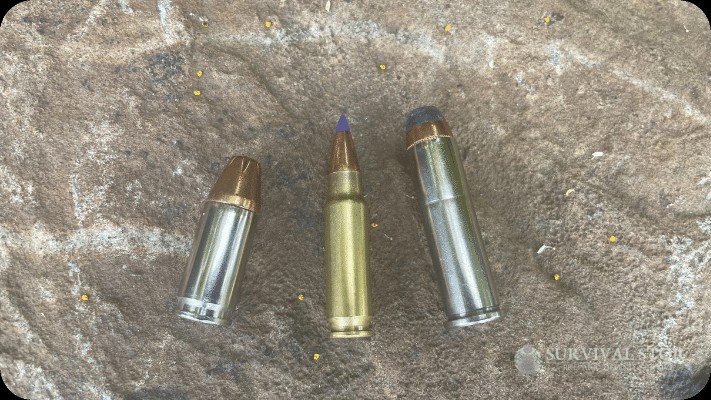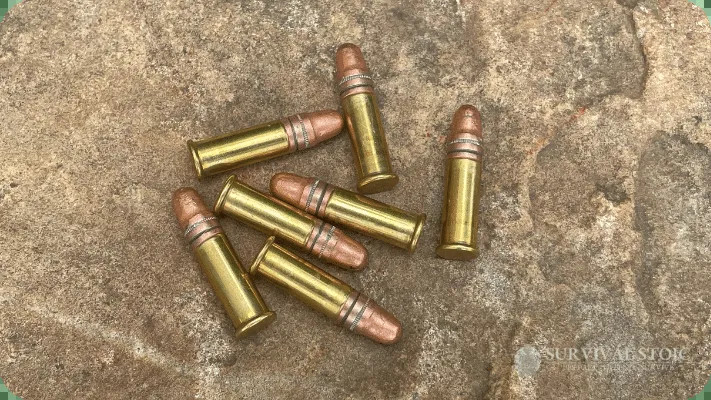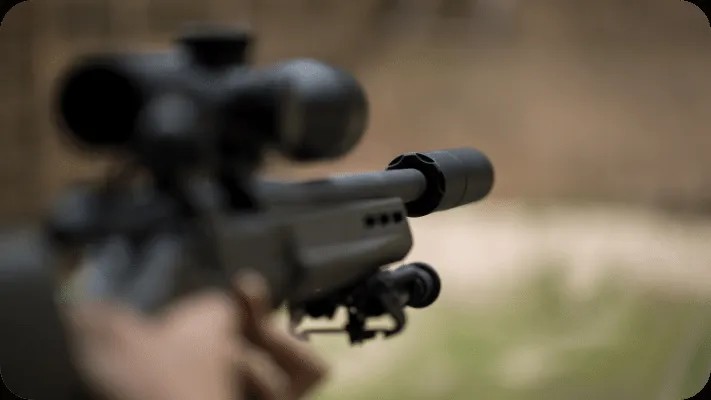Are you curious about how fast a pistol bullet travels? The velocity of a pistol bullet is a crucial factor in understanding its impact and range. At SIXT.VN, we aim to provide comprehensive travel and safety information, and understanding bullet speed is essential for responsible firearm handling and awareness. Join us as we delve into the science behind bullet velocity, factors affecting it, and why it matters. Let’s explore bullet speed, muzzle velocity, and projectile motion.
1. What is the Average Speed of a Pistol Bullet?
The average speed of a pistol bullet typically ranges from 700 to 1,500 miles per hour (mph). However, this speed varies depending on several factors, including the caliber of the bullet, the type of firearm, and the specific ammunition used.
- Caliber Matters: Smaller caliber bullets generally have lower velocities compared to larger calibers.
- Firearm Type: Pistols with longer barrels tend to produce higher bullet velocities due to the increased time for propellant combustion.
- Ammunition Type: Different types of ammunition, such as standard pressure or +P (higher pressure) rounds, can significantly affect bullet speed.
 9mm, 5.7 x 28, and 357 Magnum Bullets
9mm, 5.7 x 28, and 357 Magnum Bullets
2. What Factors Influence How Fast a Pistol Bullet Travels?
Several key factors influence the speed of a pistol bullet. Understanding these factors helps in appreciating the complexities of ballistics.
2.1 Caliber and Cartridge Design
The caliber and design of the cartridge significantly impact bullet velocity. A smaller, lighter bullet in a longer cartridge generally travels faster than a larger, heavier bullet in a shorter cartridge. This is primarily because:
- Bullet Weight: Lighter bullets require less force to accelerate, allowing them to achieve higher speeds.
- Cartridge Size: Longer cartridges can hold more propellant, generating greater energy to propel the bullet.
2.2 Bullet Weight
The weight of the bullet is a critical determinant of its velocity. Heavier bullets require more energy to reach a certain speed, resulting in lower velocities compared to lighter bullets of the same caliber. Bullet weight is typically measured in grains. For example, in 9mm ammunition, common bullet weights include 115, 124, and 147 grains.
- 9mm Example: A 115-grain bullet will generally have a higher velocity than a 147-grain bullet fired from the same pistol.
2.3 Gunpowder Amount and Type
The amount and type of gunpowder used in the cartridge play a crucial role in determining bullet velocity. More gunpowder generally results in higher velocities, but the type of powder also matters.
- Burning Rate: Slower-burning powders are often used in rifles to maintain pressure over a longer barrel length, while faster-burning powders are more common in handguns.
- Propellant Efficiency: Different powders have varying energy densities, affecting the amount of energy transferred to the bullet.
2.4 Barrel Length
Barrel length directly affects bullet velocity. A longer barrel provides more time for the expanding gases from the propellant to act on the bullet, resulting in higher speeds. This is why rifles typically have higher muzzle velocities than handguns.
- Acceleration Time: Longer barrels allow the bullet to accelerate for a longer period, maximizing its velocity before exiting the firearm.
2.5 Bullet Type and Design
The type and design of the bullet also influence its velocity. Factors such as the bullet’s shape, material, and coating affect its friction within the barrel and its aerodynamic properties in flight.
- Coating: Bullets are often coated with copper or polymer to reduce friction within the barrel, allowing for smoother passage and higher velocities.
- Aerodynamics: Streamlined bullet designs reduce air resistance, helping to maintain velocity over longer distances.
3. Common Pistol Calibers and Their Bullet Speeds
Here’s a table summarizing the typical muzzle velocities of common pistol calibers:
| Caliber | Muzzle Velocity (fps) | Muzzle Velocity (mph) |
|---|---|---|
| .22LR | 1,070 fps | 730 mph |
| 5.7 x 28mm | 2,034 fps | 1,387 mph |
| .380 Auto | 955 fps | 651 mph |
| .38 Special | 865 fps | 590 mph |
| .357 Magnum | 1,420 fps | 968 mph |
| 9mm | 1,150 fps | 784 mph |
| .40 S&W | 1,020 fps | 695 mph |
| .45 ACP | 886 fps | 604 mph |
| 10mm | 1,180 fps | 805 mph |
| .500 S&W Magnum | 1,940 fps | 1,323 mph |
3.1 .22LR
The .22LR (Long Rifle) is a popular rimfire cartridge known for its low recoil and affordability. It is commonly used for target shooting, plinking, and small game hunting. The .22LR typically travels at around 1,070 fps (730 mph).
 .22 LR cartridges
.22 LR cartridges
3.2 9mm
The 9mm is one of the most popular handgun calibers worldwide, favored for its balance of power, capacity, and manageable recoil. It is widely used by law enforcement, military personnel, and civilians for self-defense. The average 9mm bullet travels at around 1,150 fps (784 mph).
 Various 9mm cartridges
Various 9mm cartridges
3.3 .45 ACP
The .45 ACP (Automatic Colt Pistol) is a classic handgun caliber known for its stopping power. It has been a favorite among military and law enforcement personnel for over a century. The average .45 ACP bullet travels at around 886 fps (604 mph).
3.4 .357 Magnum
The .357 Magnum is a powerful revolver cartridge known for its high velocity and energy. It is often used for hunting and self-defense, offering significant stopping power. The average .357 Magnum bullet travels at around 1,420 fps (968 mph).
4. Handgun vs. Rifle Bullet Speeds
Generally, rifle bullets travel faster than handgun bullets. This is due to the longer barrels of rifles, which allow for more complete combustion of the propellant and greater acceleration of the bullet.
| Comparison Point | Handgun | Rifle |
|---|---|---|
| Barrel Length | Shorter (typically 3-6 inches) | Longer (typically 16-24 inches) |
| Propellant | Smaller cartridges with less propellant | Larger cartridges with more propellant |
| Muzzle Velocity | Lower (700-1,500 mph) | Higher (2,000-3,500 mph) |
| Effective Range | Shorter (typically 25-50 yards) | Longer (typically 100-500 yards) |
| Common Calibers | 9mm, .45 ACP, .38 Special, .40 S&W, .357 Mag | .223 Remington, 5.56mm, .308 Winchester, 7.62×39 |
5. Why Bullet Speed Matters: Impact and Applications
Bullet speed is a critical factor in determining a bullet’s impact, range, and effectiveness. Understanding bullet velocity is essential for various applications, including:
- Self-Defense: Higher bullet speeds generally result in greater stopping power, increasing the likelihood of incapacitating a threat.
- Hunting: Bullet speed affects the range and penetration of a bullet, influencing its ability to ethically harvest game.
- Target Shooting: Consistent bullet velocities are crucial for accuracy and precision in target shooting competitions.
- Law Enforcement and Military: Bullet speed is a key factor in selecting ammunition for duty weapons, ensuring effective performance in combat situations.
5.1 The Physics of Bullet Speed
The relationship between a bullet’s mass, velocity, and energy is governed by the equation:
Kinetic Energy (KE) = 0.5 * Mass * Velocity²
This equation demonstrates that kinetic energy, which determines the bullet’s potential to inflict damage, is directly proportional to its mass and the square of its velocity. Thus, even a small increase in velocity can significantly increase the bullet’s energy and impact.
5.2 Practical Considerations
While higher bullet speeds are often desirable, there are practical limitations to consider. Factors such as:
- Firearm Design: The design and construction of the firearm must be able to withstand the pressures generated by high-velocity ammunition.
- Recoil: Higher bullet speeds often result in increased recoil, which can affect the shooter’s ability to maintain accuracy.
- Ammunition Availability: High-velocity ammunition may be more expensive or difficult to obtain than standard pressure rounds.
6. Subsonic vs. Supersonic Bullets
Bullets are often categorized as either subsonic or supersonic, depending on whether their velocity is below or above the speed of sound (approximately 1,125 feet per second or 767 mph at sea level).
6.1 Subsonic Bullets
Subsonic bullets travel at speeds below the speed of sound. These bullets are often used in conjunction with suppressors to reduce the noise signature of firearms.
- Reduced Noise: Subsonic bullets do not produce a sonic boom, making them quieter than supersonic rounds.
- Applications: Commonly used in suppressed firearms for covert operations, hunting, and target shooting.
6.2 Supersonic Bullets
Supersonic bullets travel at speeds above the speed of sound. These bullets produce a sonic boom, which can be quite loud.
- Higher Energy: Supersonic bullets generally have higher kinetic energy and greater range than subsonic rounds.
- Applications: Widely used in military, law enforcement, and civilian applications where maximum range and stopping power are required.
 Rifle Suppressor
Rifle Suppressor
7. The Impact of Bullet Speed on Travel and Safety
Understanding bullet speed is crucial not only for responsible firearm ownership but also for ensuring safety during travel and recreational activities. Whether you’re a tourist exploring Vietnam or a local resident, awareness of firearm safety measures and regulations is essential.
7.1 Responsible Firearm Handling
- Safe Storage: Always store firearms in a secure location, away from unauthorized individuals.
- Proper Training: Seek professional training in firearm handling and safety procedures.
- Legal Compliance: Familiarize yourself with local firearm laws and regulations.
7.2 Travel Safety
- Awareness: Be aware of your surroundings and report any suspicious activity to law enforcement.
- Emergency Preparedness: Know the locations of emergency services and medical facilities.
- Local Laws: Respect local laws and customs regarding firearms and other weapons.
8. SIXT.VN: Your Travel Partner in Vietnam
At SIXT.VN, we are dedicated to providing exceptional travel services and valuable information to help you make the most of your journey in Vietnam. From airport transfers to hotel bookings and guided tours, we offer a wide range of services to meet your needs.
8.1 Comprehensive Travel Solutions
- Airport Transfers: Start your trip stress-free with our reliable airport transfer services.
- Hotel Bookings: Choose from a wide selection of hotels to suit your budget and preferences.
- Guided Tours: Explore the cultural and historical landmarks of Hanoi with our expert-led tours.
8.2 Ensuring Your Safety and Comfort
- Trusted Services: We partner with reputable providers to ensure the highest standards of safety and quality.
- Local Expertise: Our team of local experts is available to provide assistance and recommendations throughout your trip.
- Customer Support: We offer 24/7 customer support to address any questions or concerns you may have.
9. FAQs: Understanding Pistol Bullet Speed
9.1 What is muzzle velocity?
Muzzle velocity is the speed of a bullet as it exits the barrel of a firearm, measured in feet per second (fps) or miles per hour (mph). It is a crucial factor in determining the bullet’s range, impact, and overall effectiveness.
9.2 How does barrel length affect bullet speed?
Longer barrels allow for more complete combustion of the propellant and greater acceleration of the bullet, resulting in higher muzzle velocities.
9.3 What is the difference between subsonic and supersonic bullets?
Subsonic bullets travel below the speed of sound (approximately 1,125 fps), while supersonic bullets travel above the speed of sound. Subsonic rounds are often used with suppressors to reduce noise.
9.4 Why is bullet speed important for self-defense?
Higher bullet speeds generally result in greater stopping power, increasing the likelihood of incapacitating a threat in self-defense situations.
9.5 How does bullet weight affect velocity?
Lighter bullets require less energy to reach a certain speed, resulting in higher velocities compared to heavier bullets of the same caliber.
9.6 What is kinetic energy, and how does it relate to bullet speed?
Kinetic energy is the energy of motion, and it is directly proportional to the mass and the square of the velocity of a bullet. Higher bullet speeds result in greater kinetic energy and a more significant impact.
9.7 What factors other than speed contribute to a bullet’s effectiveness?
Other factors include bullet design, accuracy, penetration, and terminal ballistics (how the bullet behaves upon impact with a target).
9.8 Can bullet speed be increased by modifying a firearm or ammunition?
Yes, but modifications can be dangerous and may violate firearm laws. It is essential to consult with a qualified gunsmith or ballistics expert before making any modifications.
9.9 How do temperature and altitude affect bullet speed?
Temperature and altitude can affect air density, which in turn can influence bullet speed and trajectory. Higher temperatures and altitudes generally result in lower air density and slightly higher bullet speeds.
9.10 What is the role of bullet speed in hunting?
Bullet speed affects the range, penetration, and expansion of a bullet, influencing its ability to ethically harvest game. Hunters must select ammunition with appropriate bullet speeds for the intended game and hunting conditions.
10. Conclusion: Travel Safely and Explore Vietnam with SIXT.VN
Understanding how fast a pistol bullet travels is essential for responsible firearm ownership and safety awareness. At SIXT.VN, we are committed to providing valuable information and top-notch travel services to ensure your visit to Vietnam is both safe and enjoyable. Whether you’re exploring the bustling streets of Hanoi or venturing into the serene countryside, let us be your trusted travel partner.
Ready to explore Vietnam with ease and confidence? Contact SIXT.VN today to book your airport transfer, hotel, tour or flight. Let us help you create unforgettable memories while ensuring your safety and comfort every step of the way.
Address: 260 Cau Giay, Hanoi, Vietnam
Hotline/WhatsApp: +84 986 244 358
Website: SIXT.VN



